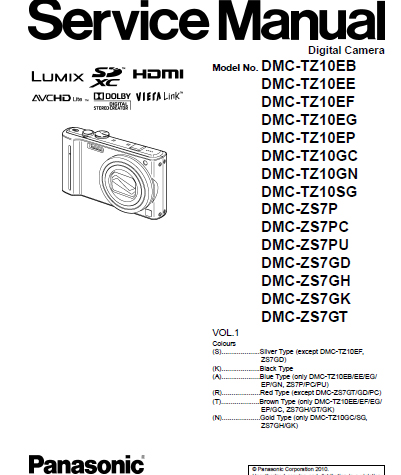This Panasonic Lumix DMC-TZ10 Service Manual contains technical information, which will allow service personnel's to understand and service this model. Please place orders using the parts list and not the drawing reference numbers. If the circuit is changed or modified, the information will be followed by service manual to be controlled with original service manual. The lead free solder has been used in the mounting process of all electrical components on the printed circuit boards used for this equipment in considering the globally environmental conservation. The normal solder is the alloy of tin (Sn) and lead (Pb). On the other hand, the lead free solder is the alloy mainly consists of tin (Sn), silver (Ag) and Copper (Cu), and the melting point of the lead free solder is higher approx.30 °C (86 °F) more than that of the normal solder. This service information is designed for experienced repair technicians only and is not designed for use by the general public. It does not contain warning or caution to advise non technical individuals of potential dangers in attempting to service a product. Products powered by electricity should be serviced or repaired only by experienced professional technicians. Any attempt to service or repair the product or products dealt with in this service information by anyone else could result in serious injury or death.
There are special components used in this equipment which are important for safety. These parts are marked by in the Schematic Diagrams, Circuit Board Layout, Exploded Views and Replacement Parts List. It is essential that these critical parts should be replaced with manufacturer’s specified parts to prevent X-RADIATION, shock fire, or other hazards. Do not modify the original design without permission of manufacturer. An Isolation Transformer should always be used during the servicing of AC Adaptor whose chassis is not isolated from the AC power line. Use a transformer of adequate power rating as this protects the technician from accidents resulting in personal injury from electrical shocks. It will also protect AC Adaptor from being damaged by accidental shorting that may occur during servicing. When servicing, observe the original lead dress. It a short circuit is found, replace all parts which have been overheated or damaged by the short circuit.
Plug the AC cord directly into the AC outlet. Do not use an isolation transformer for this check. Connect a 1.5kΩ, 10 W resistor, in parallel with a 0.15μF capacitor, between each exposed metallic part on the set and a good earth ground, as shown in Figure 1. Use an AC voltmeter, with 1 kΩ/V or more sensitivity, to measure the potential across the resistor. Check each exposed metallic part, and measure the voltage at each point. Reverse the AC plug in the AC outlet and repeat each of the above measurements. The potential at any point should not exceed 0.75 V RMS. A leakage current tester (Simpson Model 229 or equivalent) may be used to make the hot checks, leakage current must not exceed 1/2 mA. In case a measurement is outside of the limits specified, there is a possibility of a shock hazard, and the equipment should be repaired and rechecked before it is returned to the customer. Unplug the AC cord and connect a jumper between the two prongs on the plug. Measure the resistance value, with an ohmmeter, between the jumpered AC plug and each exposed metallic cabinet part on the equipment such as screwheads, connectors, control shafts, etc. When the exposed metallic part has a return path to the chassis, the reading should be between 1MΩ and 5.2MΩ. When the exposed metal does not have a return path to the chassis, the reading must be infinity.
Panasonic Lumix DMC-TZ10 Service Manual here

0 Response to "Panasonic Lumix DMC-TZ10 Service Manual"
Post a Comment